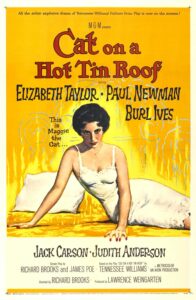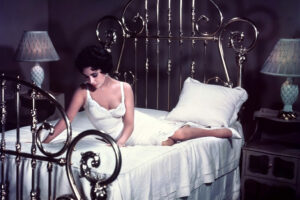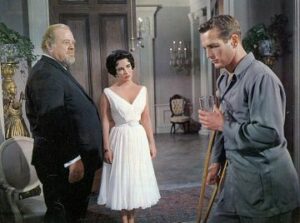“Cat on a Hot Tin Roof” – the Pain of Passion

Title: “Cat on a Hot Tin Roof”
Release Date: 1958
Director: Richard Brooks
Cast: Elizabeth Taylor, Paul Newman, Burl Ives, Jack Carson, Judith Anderson, Madeleine Sherwood
The popularity of screen adaptations of Tennessee Williams’ works reached its peak in the 1950s, when such works as “The Glass Menagerie” and A Streetcar Named Desire were transferred to the cinema. Another important film was “Cat on a Hot Tin Roof” directed by Richard Brooks. The filmmaker, bound by censorship, emphasized even more strongly the emotional theme of the film, which is the cultural repression of sex and the attempt to tame it in socially acceptable forms.
“Cat on a Hot Tin Roof” – family crisis in the face of the death of the family patriarch
“Cat on a Hot Tin Roof” is set in the southern United States, in the state of Mississippi, on the estate of a local cotton tycoon. The rich man’s 65th birthday is approaching, and his whole family is coming: his two adult sons with their wives, and his grandchildren. Grandfather (Burl Ives) has just returned from the country’s top medical clinic convinced that a suspected fatal disease has turned out to be wrong. Meanwhile, older son Gooper (Jack Carson) and his wife Mae (Madeleine Sherwood), knowing the truth about Grandpa’s cancer, try to get him to bequeath the estate to them. Also hoping for an inheritance is Maggie (Elizabeth Taylor) wife of his younger son, Brick (PaulNewman).
Unfortunately, Brick, a former soccer star, is sinking into alcoholism and has no intention of getting involved in family disputes. His marriage to Maggie exists only formally. The couple has not slept together for years, although the woman does her best to seduce her frigid husband. Meanwhile, Gooper cannot complain about his marriage – he already has five children, and the sixth is about to be born. On the night of the birthday party, all the brakes are released – each member of the family spills their long-held grudges and secrets. This leads to a dramatic argument, but also to a cleansing that will result in the creation of a new family order.

“Cat on a Hot Tin Roof” – Freudian repressed drives
“Cat on a Hot Tin Roof” is a psychodrama that reveals the hidden motivations behind the characters’ actions. It is primarily about sexuality repressed by traditional cultural patterns. These become glaringly apparent in the southern United States, a hotbed of conservatism and tradition. Each of the characters, constructed along the lines of Sigmund Freud’s theory, harbors erotic frustration that is a source of suffering.
Most obvious is the situation of Maggie spurned by her husband in the erotic sphere. Maggie, contrary to patriarchal patterns, is a woman of great sexual temperament. This is evident, of course, in her attempts to seduce her husband and her direct demands for intimacy, but more importantly in the way her character is filmed. The stunningly beautiful Elizabeth Taylor in sexy lingerie, invitingly stretched out on a large bed are almost iconic shots from “Cat on a Hot Tin Roof”. The marital bed itself, at the center of the scenes ripping between Maggie and Brick, is a symbolic prop. So, for example, is the bullet that Brick uses because of his broken leg. It signifies not only the man’s literal disability, but also his sexual problems. In the course of the plot, it turns out that Brick’s frigidity is not necessarily caused by his grudge against his wife, who, he assumes, cheated on him with his best friend, but by the fact that he himself had a homosexual relationship with his friend.
The brothers’ marriages are presented in contrasting ways. Gooper and his wife are the complete opposite of Maggie and Brick’s relationship. The infertility of the first couple is in stark contrast to the excessive procreation of the second. Nevertheless, also in this case we are dealing with hidden motives of actions. The couple’s constant invocation and presentation of children and Mae’s apparent pregnancy seem to be the most important bargaining chip they have in the dispute over the inheritance of the estate. The objectification of the children is particularly evident in the scene when Mae completely breaks down upon hearing of Maggie’s pregnancy. Sex and its results are therefore not a value in themselves, but are reduced to a kind of currency to settle seemingly unrelated matters.

Also of interest is the marriage of the family’s seniors, which also seems to harbor many secrets. The grandmother (Judith Anderson) apparently hides something from Gooper, the eldest son, because she does not want to reveal why his father, despite his efforts, has always favored Brick. What is more, the woman in one of the scenes mentions rather unclear and peculiar circumstances of her wedding, when she was already four months pregnant. Furthermore, it can be assumed that Gooper is not Grandfather’s biological son. The patriarch of the family, on the other hand, is only seemingly a happy and faithful husband. For he says that for 40 years he has had to repress his true erotic needs and satisfy them with a woman he is not attracted to. When he is convinced that he will live a long life after all, he even plans to find himself a young attractive lover.
“Cat on a Hot Tin Roof” – men’s fear of the animal instinct of femininity
The movie “Cat on a Hot Tin Roof” has a symbolic and multidimensional title. It refers to Maggie herself, who describes herself in precisely this way, claiming that her most important task is to endure her own uncomfortable position for as long as possible. The cat as a metaphor also refers to a woman’s erotic and maternal desires. Another animalistic metaphor, that of the “queen,” also appears in the film, which is how Grandfather refers to Gooper’s wife, having in mind her fertility.
Femininity in Brooks’ film is thus associated with animalism – predation (represented primarily by Grandmother), the primal instinct for sex and procreation. As such, femininity instills fear in men. Every action of the male characters is lined with fear of losing power and the uncontrollable eruption of female sexuality. The coping strategy is the refusal of intimacy, which makes men safe and resistant to the power of desire. It is also the continual procreation of offspring – a form of imprisonment for the woman and the taming of her libido. Finally, it is the grandfather’s openly demonstrated power and disregard for his wife and daughter-in-law. And in each case the position of the woman remains the same – she is a cat trying to stay on the hot tin roof of her own desires and male fears.

“Cat on a Hot Tin Roof“ – social forms
It turns out, then, that paradoxically the only remedy for erotic frustrations is to shut them down in socially accepted forms, and therefore to repress them. This is exactly what happens in the finale of “Cat on a Hot Tin Roof”. Brick hides his homosexuality by conceiving an offspring with Maggie, Gooper controls his irritable wife by taking advantage of her entanglement in maternal duties, and Grandpa comes to terms with his sons and tames his senile lust by hiding it under a mask of respect for his wife. The film’s ending thus gains an ironic sense: for culture (marriage and family) is not only, as Freud said, “the source of suffering” but also the only method of relieving it.
Literature:
„Kino klasyczne”, pod red. T. Lubelskiego, I. Sowińskiej, R. Syski, Kraków 2012.

